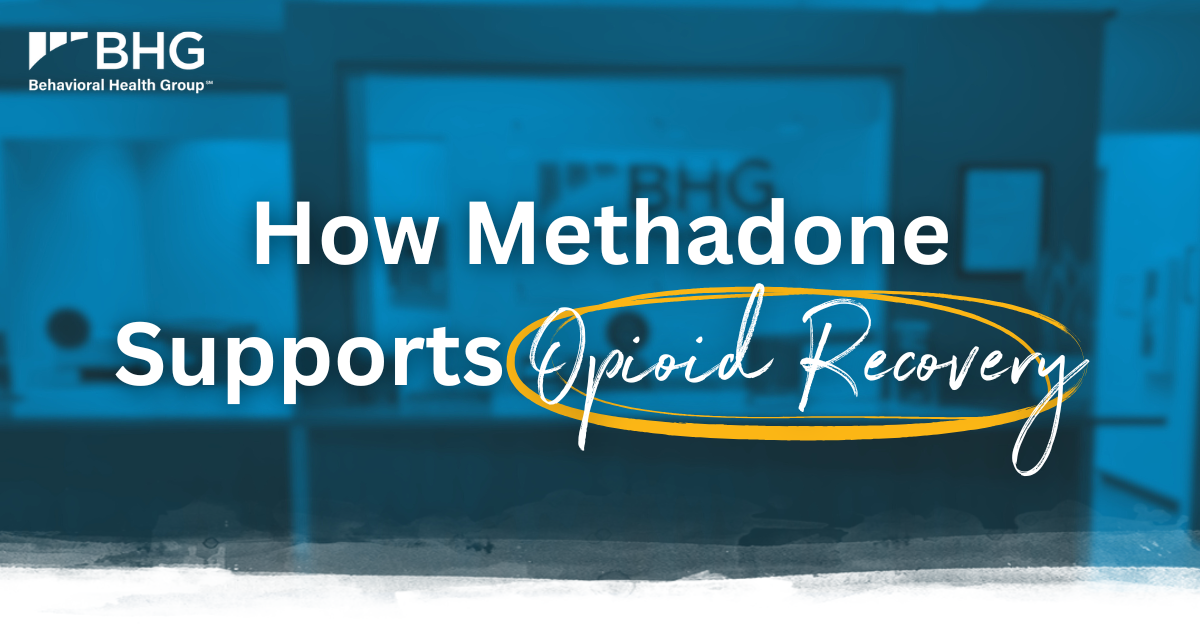
Opioid use disorder (OUD) doesn't just produce cravings--there can be physical pain – emotional highs and lows and the fear of slipping back into old habits. But, with the right tools and support, every day becomes an opportunity to feel more in control and more like yourself again.
This is where methadone can make a real difference. As an FDA-approved medication for OUD, which is the medical term used instead of ‘addiction,’ methadone helps manage cravings and withdrawal symptoms, giving people the support they need to stay focused on their recovery. But how does it actually work? And why is it so effective? Let’s dive into how methadone helps with opioid recovery and pain management—and why it’s a vital part of the process.
What is Methadone?
Think of methadone as a synthetic opioid, but it works a little differently than the opioids you might be familiar with. While it attaches to the same brain receptors as drugs like heroin or prescription painkillers, methadone doesn’t give you the “high” that comes with those substances.
Instead, methadone helps ease cravings and withdrawal symptoms, making it a go-to treatment for opioid use disorder (OUD). It's also classified as a Schedule II controlled substance, which means it’s closely monitored because it can be misused if not properly managed.
Given how powerful methadone can be, it’s always taken under supervision. That’s why it’s typically provided through Opioid Treatment Programs (OTPs), where healthcare providers make sure it’s used safely and effectively, supporting you on the path to recovery.
How Methadone Works
Methadone works by attaching to opioid receptors in the brain, reducing cravings and withdrawal symptoms. Unlike heroin or painkillers, it doesn’t produce a “high” but stabilizes brain function, making addiction easier to manage. Addiction physically changes the brain, making it hard to feel "normal" without the drug, but methadone can restore balance and help you focus on recovery.

Think of it like this: when you’re going through withdrawals, your body feels out of control —cravings are intense, emotions are all over the place and your mind can feel foggy. Methadone calms that internal chaos, providing a steady effect to help you move forward in recovery.
By restoring balance to the brain, methadone alleviates opioid withdrawal symptoms like sweating, chills, and nausea.
What is Methadone Used For?
Methadone has two main uses that can make a real difference in people’s lives, offering much-needed support in challenging situations:
Methadone for Opioid Use Disorder (OUD)
Methadone plays a crucial role in treating OUD. As part of Medication-Assisted Treatment (MAT) and Medications for Opioid Use Disorder (MOUD), it helps manage cravings and withdrawal symptoms, providing stability for those in recovery. By calming the body and mind, methadone helps individuals regain confidence and stay committed to their recovery. Administered through licensed Opioid Treatment Programs (OTPs), patients receive support in a safe, controlled setting.
Methadone for Pain Management
Methadone isn’t just for addiction—it’s also used to manage chronic or severe pain. Unlike other painkillers, it provides longer-lasting relief, making it a good option for those needing ongoing pain control. Though prescribed less frequently due to its strength and need for careful monitoring, methadone offers effective pain management.

What Are the Side Effects of Methadone?
Like any medication, methadone has potential side effects. Let’s go over the common ones, along with some serious effects you’ll want to watch for:
Common Side Effects:
- Restlessness
- Slow breathing
- Heavy sweating
- Nausea or vomiting
- Itchy skin
- Constipation
Serious Side Effects:
- Difficulty breathing
- Lightheadedness or fainting
- Chest pain
- Fast or irregular heartbeat
- Hallucinations or confusion
To reduce the risk of these side effects, it's important to follow your provider's dosing guidelines. Taking more than the recommended dose can increase the risk of overdose. Always check in with your doctor if you’re feeling anything unusual.

Benefits of Methadone
Methadone has proven to be an effective tool for individuals dealing with OUD or chronic pain. Here’s why it’s so impactful:
- Reduces Cravings and Withdrawal Symptoms: Methadone helps manage both physical and emotional withdrawal symptoms, making it easier to stay focused on recovery.
- Provides Stability and Quality of Life: It supports stability, helping you keep up with work, relationships and daily responsibilities while participating in recovery programs.
- Reduces Risk of Overdose: When taken as prescribed, methadone lowers the risk of overdose compared to illegal opioids, offering a consistent, controlled dose.
- Effective Against High-Potency Opioids like Fentanyl: Methadone helps individuals safely transition off potent opioids like fentanyl, easing withdrawal and reducing relapse risks.
- High Success Rate: Studies show that methadone significantly reduces opioid use, improves recovery outcomes and decreases the risk of overdose.
How Methadone is Different from Buprenorphine
Methadone and buprenorphine are both used to treat OUD, but they work a bit differently. Methadone is a full opioid agonist, meaning it fully activates the opioid receptors in your brain. Buprenorphine—the main ingredient in Suboxone—is a partial agonist, only partially activating those receptors to help reduce cravings and withdrawal without causing a strong high.
Some believe methadone can be more beneficial for certain people. In fact, 74% of methadone patients complete their treatment, compared to just 46% of buprenorphine patients. Methadone is available only through Opioid Treatment Programs (OTPs), while buprenorphine (like Suboxone) can be prescribed both in OTPs and office-based settings (OBOTs). Both treatments are effective, but they differ in how they work and where they’re available.
See how they compare and differ below:
| Feature | Methadone | Buprenorphine | Similarities |
| Medication Type | Full opioid agonist | Partial opioid agonist | Used for opioid use disorder (OUD) treatment |
| Effect on Opioid Receptors | Fully activates opioid receptors | Partially activates opioid receptors | Helps manage withdrawal and cravings |
| Treatment Settings | Only available through OTPs | Available in OTPs and OBOTs (office-based settings) | Both require medical supervision |
| Available Forms | Liquid, powder, diskette | Tablets, film strip, and injectable | Can be part of medication-assisted treatment (MAT) |
So, if you’re trying to decide what’s best for you—methadone vs. buprenorphine—it often comes down to your individual needs, history with opioids and access to care.

Is Methadone the Right Treatment for Me?
Choosing the right treatment for OUD is a personal decision that depends on your unique situation. If you’re considering methadone, ask yourself these questions to help guide your decision:
- Am I struggling with severe OUD?
- Do I have difficulty managing cravings and withdrawal symptoms?
- Am I willing to commit to a structured treatment plan with counseling?
- Am I seeking long-term support for my addiction?
- Do I have access to a licensed Opioid Treatment Program (OTP)?
- Do I want a proven treatment option with a long track record?
Disclaimer: These questions are for guidance only. Please consult a healthcare provider to determine the best treatment for your individual needs.
Start Your Recovery with Safe and Effective Methadone Treatment
Recovery can feel like a lot—but you don’t have to face it alone. At BHG Recovery, we offer full support in one place: methadone treatment, counseling, case management and more. We’re also one of just 4.2% of programs nationwide that offer all three FDA-approved medications – methadone, buprenorphine and naltrexone – giving you more options to find what works best for you.
If you or a loved one are ready to start recovery or need help now, give us a call at 844-535-7291 or find a location near you.
If you’re a healthcare provider or a referring partner, please call our dedicated referral line at 866-763-2244 or submit an online referral form on our website. We’re here to help guide you in the right direction.
Frequently Asked Questions
